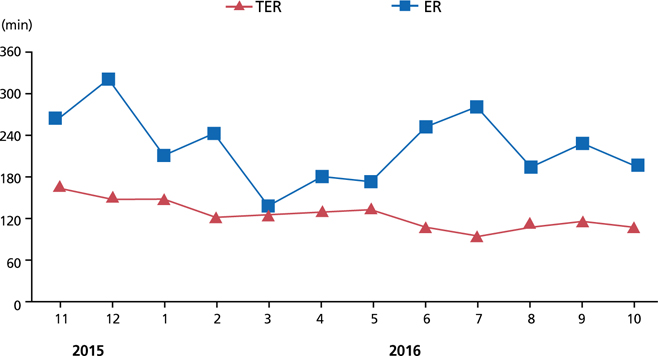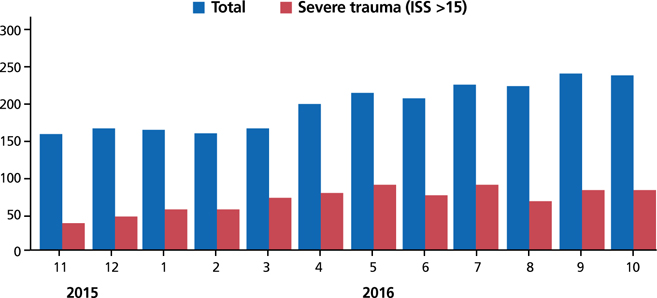J Korean Med Assoc.
2016 Dec;59(12):931-937. 10.5124/jkma.2016.59.12.931.
Proposal for stabilization of regional trauma centers in Korea
- Affiliations
-
- 1Department of Trauma and Surgical Critical Care, Trauma Center, Pusan National University Hospital, Busan, Korea. csking1@daum.net
- KMID: 2364057
- DOI: http://doi.org/10.5124/jkma.2016.59.12.931
Abstract
- From 2011 to 2016, 16 regional trauma centers were designated throughout the country and 9 of the 16 centers have been operating their own trauma facilities. At present, there are some differences in treatment experiences and levels according to the type and size of the trauma centers. Treating the trauma system as a part of emergency medical service, while the field of severe trauma is clearly different from the rest of emergency medical service in particular, has become a serious problem in Korea. First of all, the role of trauma centers should have been established before they are added to the trauma care system. Beyond that, manpower is the most important factor in building a trauma center. Pusan National University Hospital offers the ideal environment for a study on the relationship between trauma centers and emergency centers. Pusan National University Hospital has 2 independent emergency rooms: one each in the trauma center and emergency center. Therefore, it is possible to compare the outcomes of 2 different emergency rooms and identify the proportion of the trauma population who is transferred from the emergency center to the trauma center due to trauma severity index. Ultimately, the government and individual hospitals must support personnel in each trauma centers administratively and financially to sustain trauma centers over the long term. The purpose of this proposal is to suggest some resolutions to the problems associated with the trauma care system in Korea.
MeSH Terms
Figure
Cited by 1 articles
-
Influence of Secondary Trauma Stress, and Vocation on Turnover Intention of Nurses in Regional Trauma Centers
Hyun-Gwan Lee, Ji-Soo Kim
J Korean Acad Nurs Adm. 2020;26(1):65-72. doi: 10.11111/jkana.2020.26.1.65.
Reference
-
1. Moon S, Lee SH, Ryoo HW, Kim JK, Ahn JY, Kim SJ, Jeon JC, Lee KW, Sung AJ, Kim YJ, Lee DR, Do BS, Park SR, Lee JS. Preventable trauma death rate in Daegu, South Korea. Clin Exp Emerg Med. 2015; 2:236–243.
Article2. Korean Statistical Information Service. Deaths, death rates, age-standardized death rates by cause (50 item) and sex: si, gun, and gu [Internet]. Daejeon: Statistics Korea;2014. cited 2015 Aug 31. Available from: http://kosis.kr/statisticsList/statisticsList_01List.jsp?vwcd=MT_ZTITLE&parentId=Ds.3. Jung KY, Kim JS, Kim Y. Problems in trauma care and preventable deaths. J Korean Soc Emerg Med. 2001; 12:45–56.4. Kim Y, Jung KY, Cho KH, Kim H, Ahn HC, Oh SH, Lee JB, Yu SJ, Lee DI, Im TH, Kim SE, Park JH. Preventable trauma deaths rates and management errors in emergency medical system in Korea. J Korean Soc Emerg Med. 2006; 17:385–394.5. Kim H, Jung KY, Kim SP, Kim SH, Noh H, Jang HY, Yoon HD, Heo YJ, Ryu HH, Jeong TO, Hwang Y, Ju JM, Joo MD, Han SK, Cho KW, Choi KH, Park JM, Jung HM, Lee SB, Kyong YY, Ryu JY, Jeon WC, Ahn JY, Lee JY, Ji HJ, Lee TH, Kim OH, Cha YS, Cha KC, Lee KH, Hwang SO. Changes in preventable death rates and traumatic care systems in Korea. J Korean Soc Emerg Med. 2012; 23:189–197.6. Kang JH, Park KH, Kim WJ, Kang YJ, Park JO, Cha WC, Kim K, Choi TM, Kang JA, Moon YS, Hong MK. Problems of trauma care and rate of preventable trauma death in Jeju, South Korea. J Korean Soc Emerg Med. 2011; 22:438–445.7. Kim SC, Song KJ, Shin SD, Lee SC, Park JO, Holmes JF. Preventable deaths in patients with traumatic brain injury. Clin Exp Emerg Med. 2015; 2:51–58.
Article8. Choi YH, Ahn KO, Shin SD, Song KJ, Park JO, Hong W, Hong KJ, Noh H. Compliance of a bypassing hospital trauma protocol using the field triage decision scheme between metropolitan vs non-metropolitan emergency medical services. J Korean Soc Emerg Med. 2015; 26:138–148.9. Cummings GE, Mayes DC. A comparative study of designated Trauma Team Leaders on trauma patient survival and emergency department length-of-stay. CJEM. 2007; 9:105–110.
Article10. Reichard AA, Marsh SM, Moore PH. Fatal and nonfatal injuries among emergency medical technicians and paramedics. Prehosp Emerg Care. 2011; 15:511–517.
Article11. Jang HY, Kim DK, Kwak YH. Use of pediatric emergency department in Korea: nation-wide data analysis [abstract I2H2-6]. In : Korean Society of Emergency Medicine. 2010 Fall Scientific Meeting; 2010 Oct 21; Seoul, Korea. Seoul: Korean Society of Emergency Medicine;2010.12. Lee SJ, Kim HB, Kim DK, Kwak YH. A national survey of current practice pattern and preparedness of pediatric emer-gency care in Korea [abstract I2H2-1]. In : Korean Society of Emergency Medicine. 2010 Fall Scientific Meeting; 2010 Oct 21; Seoul, Korea. Seoul: Korean Society of Emergency Medi-cine;2010.13. Kim DK. Regionalization of pediatric emergency care in Korea. Korean J Pediatr. 2011; 54:477–480.
Article14. Hong KH, Lee KJ, Kim JT, Lee DH. Severity-based analysis of prehospital transportation time using the geographic information system (GIS). J Korean Soc Emerg Med. 2008; 19:153–160.15. Sasser SM, Hunt RC, Sullivent EE, Wald MM, Mitchko J, Jurkovich GJ, Henry MC, Salomone JP, Wang SC, Galli RL, Cooper A, Brown LH, Sattin RW. National Expert Panel on Field Triage, Centers for Disease Control and Prevention (CDC). Guidelines for field triage of injured patients. Recommendations of the National Expert Panel on Field Triage. MMWR Recomm Rep. 2009; 58(RR-1):1–35.16. Newgard CD, Nelson MJ, Kampp M, Saha S, Zive D, Schmidt T, Daya M, Jui J, Wittwer L, Warden C, Sahni R, Stevens M, Gorman K, Koenig K, Gubler D, Rosteck P, Lee J, Hedges JR. Out-of-hospital decision making and factors influencing the regional distribution of injured patients in a trauma system. J Trauma. 2011; 70:1345–1353.
Article17. Hwang JH, Lee JY, Park SW, Lee DW, Lee BW, Na BJ. The analysis of underserved emergency medical services areas in Daejeon metropolitan city using a geographic information system. J Agric Med Community Health. 2012; 37:76–83.
Article18. Doumouras AG, Haas B, Gomez D, de Mestral C, Boyes DM, Morrison LJ, Craig AM, Nathens AB. The impact of distance on triage to trauma center care in an urban trauma system. Prehosp Emerg Care. 2012; 16:456–462.
Article19. Teixeira PG, Inaba K, Hadjizacharia P, Brown C, Salim A, Rhee P, Browder T, Noguchi TT, Demetriades D. Preventable or potentially preventable mortality at a mature trauma center. J Trauma. 2007; 63:1338–1346.
Article20. Ashour A, Cameron P, Bernard S, Fitzgerald M, Smith K, Wal-ker T. Could bystander first-aid prevent trauma deaths at the scene of injury? Emerg Med Australas. 2007; 19:163–168.
Article21. McDermott FT, Cordner SM, Cooper DJ, Winship VC. Consultative Committee on Road Traffic Fatalities in Victoria. Management deficiencies and death preventability of road traffic fatalities before and after a new trauma care system in Victoria, Australia. J Trauma. 2007; 63:331–338.
Article22. Xiang H, Wheeler KK, Groner JI, Shi J, Haley KJ. Undertriage of major trauma patients in the US emergency departments. Am J Emerg Med. 2014; 32:997–1004.
Article23. Lee DK, Lee KH, Cha KC, Park KH, Choi HJ, Kim H, Hwang SO. Effectiveness of simple trauma team activation criteria on prognosis of severe trauma patients. J Korean Soc Traumatol. 2009; 22:71–76.24. Kim H, Jung KY, Kim SP, Kim SH, Noh H, Jang HY, Yoon HD, Heo YJ, Ryu HH, Jeong TO, Hwang Y, Ju JM, Joo MD, Han SK, Cho KW, Choi KH, Park JM, Jung HM, Lee SB, Kyong YY, Ryu JY, Jeon WC, Ahn JY, Lee JY, Ji HJ, Kim OH, Cha YS, Cha KC, Lee KH, Hwang SO. Changes in preventable death rates and traumatic care systems in Korea. J Korean Soc Emerg Med. 2012; 23:189–197.25. Sasser SM, Hunt RC, Faul M, Sugerman D, Pearson WS, Dulski T, Wald MM, Jurkovich GJ, Newgard CD, Lerner EB. Centers for Disease Control and Prevention (CDC). Guidelines for field triage of injured patients: recommendations of the National Expert Panel on Field Triage, 2011. MMWR Recomm Rep. 2012; 61(RR-1):1–20.26. Lim H, Chang WJ, Kim SH. Distribution of time to death in trauma patients: a review of 11 years' experience at a tertiary care teaching hospital. J Korean Soc Emerg Med. 2001; 12:457–466.27. Kleber C, Giesecke MT, Tsokos M, Haas NP, Buschmann CT. Trauma-related preventable deaths in Berlin 2010: need to change prehospital management strategies and trauma management education. World J Surg. 2013; 37:1154–1161.
Article
- Full Text Links
- Actions
-
Cited
- CITED
-
- Close
- Share
- Similar articles
-
- Background and progress of regional trauma center development
- Understanding Regional Trauma Centers and managing a trauma care system in South Korea: a systematic review
- Current status and future prospects of trauma centers in Korea
- Outcomes of the support services for the establishment of regional level 1 trauma centers
- Plan for plastic surgeons to participate in trauma teams at regional trauma and emergency centers



